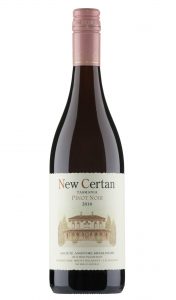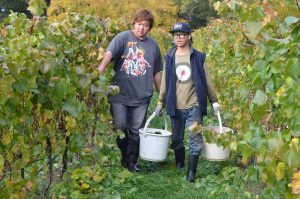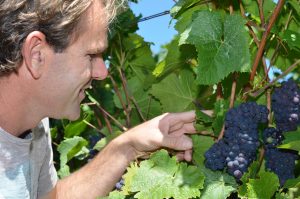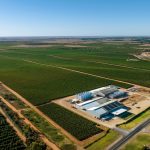Pinot possession delivers Moor in Tasmania
An ongoing project at Kreglinger Wine Estates in Tasmania’s north is presenting opportunities for viticulturists to find out what makes Pinot Noir tick. The results could prove invaluable to the state’s, and Australia’s, wine industry. First published in the July 2018 issue of the Grapegrower & Winemaker magazine, Mark Smith takes up the story.
When he moved to Launceston in 2002, Kreglinger Wine Estates managing director Paul de Moor became the mystery man of the Tasmanian wine scene—a thoughtful and articulate Belgian national who preferred to travel beneath the radar, shunning publicity and maintaining limited engagement with his industry peers on the island.
Then 41 years of age and chief executive officer of northern Tasmania’s iconic Pipers Brook Vineyard, de Moor was intent on navigating a careful path between business and home life, very much the family man devoted to wife Sylvie and a thriving brood of youngsters.
But time moves on and children fly the coop. Today, de Moor’s home plays host to growing concerns of a different kind—a vineyard comprising 64 clonal selections of Pinot Noir spanning 3.3 hectares, on a site that was once part of Launceston’s renowned Mount Pleasant Estate.
It’s a property where boundaries are largely defined by neighbourhood fencing and the suburban sprawl of residential Kings Meadows.
Barely six kilometres from the CBD and set among 14ha of stately gardens replete with large deciduous European trees, its vines are rooted in silty, clayey soils that are low in nutrient and include viticulturally challenging outcrops of volcanic dolerite.
At the heart of de Moor’s estate is a gracious, two-storey Victorian structure built in 1865 for colonial whaling and shipping merchant, Henry Reed.
It was Reed, a contemporary of John Batman, who financed the first colonial voyage to Port Phillip and was regarded by William Booth as a co-founder of the Salvation Army.
A small but substantial brick ‘vinery’ is located within close proximity of the vineyard.
Curiously, it appears on faded plans that were prepared for Reed and found in a library drawer after de Moor purchased his historic property from the Holyman family in the months that followed the Belgian-owned company’s acquisition of publicly-listed Pipers Brook Vineyard in 2001.
Reed’s 19th century vinery was established to facilitate on-site production of table grapes.
These days, it’s equipped with the 21st century paraphernalia used for callusing, propagating and growing on Pinot Noir rootlings.
Somewhat prosaically referred to as the Pipers Brook Vineyard Vine Improvement Program when first mooted in 2005, de Moor’s privately-owned and funded initiative has since become the production base for a 200-case single vineyard Pinot Noir called New Certan.

The wine had its first vintage in 2011.
Its labelling and packaging—not to mention its Certan moniker and pastel pink neck capsule—have proved somewhat contentious in evoking de Moor’s European ancestry and wine heritage.
Great grandfather Georges Thienpont was a successful wine merchant in Belgium and purchased Pomerol’s prestigious Vieux Chateau Certan in 1924.
Almost a century later, the esteemed 16ha Bordeaux property remains in family hands, with cousin Alexandre making its wines, as well as managing a fabled vineyard down the road at Chateau Le Pin owned by garagiste winemaker and cousin, Jacques Thienpont.
Apart from a small number of selections sourced from Pipers Brook Vineyard’s own in-house catalogue of Pinot Noir dating back to the late 1970s, the vast bulk of New Certan’s vines are generation-one plantings, derived from clones that have been virus and DNA-tested, and virtually guaranteed to be true to type.

Harvesting New Certan Pinot Noir
During the vineyard’s planning phase and earliest years of development, its key viticultural consultant was Wayne Farquhar, then executive officer of South Australian Vine Improvement Inc and nowadays the driving force behind Dell’uva Wines, a family-owned vineyard in the North Mount Lofty Ranges of South Australia which plays host to one of the country’s largest collections of European grape varieties.
With Farquhar’s help, a significant number of Pinot Noir selections were obtained from sites spread throughout the Australian wine industry.
Others were obtained overseas, from reputable sources as far afield as the United States, Germany, Italy, Portugal and, of course, France.
Selections brought into the country from overseas required a costly and time-consuming two-year period in quarantine.
On-ground support for the project has been provided by the late Graham Wiltshire and legendary cool climate viticulture specialist, Ray Guerin.
It was Wiltshire’s pioneering plantings at Heemskerk Wines in 1975 that ultimately formed the basis of the highly successful block-to-label approach developed for Pipers Brook Vineyard’s super-premium Lyre, Blackwood and Reserve Pinot Noir brands by company founder Dr Andrew Pirie.
Careful monitoring and meticulous record keeping by Wiltshire and former Pipers Brook vineyard manager, Bruce McCormack, more than a decade ago revealed significant clonal differences in callusing rates and in the development of buds and shoots.
In 2007, 28 clonal selections, accounting for 1.32ha of vines, were planted on their own roots in the new vineyard.
An additional 1.4ha of Pinot Noir were planted in November 2009.
These included three dozen selections planted on their own roots, as well as 30 different selections grafted on to common rootstocks like 101/14. A pre-existing block of 0.54ha – planted by the Holymans in 1984 – brings the site’s total Pinot Noir assets to 3.3ha.
Vineyard visitors, both welcome and unwelcome, will be disappointed if they expect to find clonal accession numbers boldly emblazoned on vineyard posts.
Instead, they’ll be met by much more cryptic descriptors – such as PBV1, PBV2, and PBV64 – tags specially coded to mask true vine identities.
De Moor says his selections have a planting density of around 10,000 vines per hectare.
Their layout is quite unique within the context of the Tasmanian industry.
Vines are arranged in rows set 2.0m apart, with pairs of vines sharing a single hole dug in the ground at 1.0m intervals.
Leaf canopies are trained upwards in a far more conventional VSP arrangement, however.
The story goes that McCormack had seen a similar management system in operation during a trip to Italy in 2005.
It was one of several dozen trials being evaluated in a vineyard research program directed by Professor Leonardo Valenti from the University of Milan.
Valenti believed wines made from the double trunk vines produced far superior wines compared with others, including ones made using more traditional planting methods.
The researchers proposed the system reduced the amount of variability in a vineyard block because of the way in which it forced pairs of vines to compete for nutrition.
More than a decade later, Kreglinger Wine Estates chief viticulturist, Fred Strachan, is sceptical about the claims and will see what happens.
Born in Renmark, Strachan spent 14 years working with Yalumba before moving to Tasmania to take up his appointment in the state’s north in September 2016.

Viticulturist and Kreglinger Wine Estates vineyard manager Fred Strachan with Pinot Noir bunches
“At the time, I really wondered why anyone would want to take on a project of such complexity,” Strachan mused.
“It sounds a little bit crazy, doesn’t it? I worked with Nick Dry at Yalumba Nursery for three or four years and I’ve never heard of anything like it anywhere else. But vine improvement programs are very familiar territory to me. And the truth is, this project presents us with an amazing range of opportunities to find out what really makes Pinot Noir tick. Obviously the performance of some clonal selections will be less than ideal – it’s not going to be all good news for the company – but what we find out here should prove to be invaluable to the Tasmanian wine industry, and to the Australian industry as a whole at some point in time.
“I’ve already done a review of the project for Paul and Ray, and while I know there are some clones there that people elsewhere in the industry already have, others I know for sure are new to the industry, and some of those look pretty amazing. That’s not to say we’re already ruling out the value of our pre-existing Pinot Noir resources. Not everything that’s shiny and new performs to expectation.”
The pitfalls of jumping to conclusion have not been lost on Kreglinger Wine Estates chief winemaker, Jim Chatto.
Appointed to the position in August of 2017, the Hunter Valley veteran has 25 years of winemaking experience behind him, and made his first Tasmanian Pinot Noir in 1998 with Dr Mike Beamish at Rosevears Estate in the Tamar Valley.
Chatto’s abiding love for the variety has seen him producing Pinot Noir wines under his own label since 2000.
Along with wife Daisy and two young daughters, Chatto has lived a dual life in recent years, developing a new home and Pinot Noir vineyard in Tasmania’s Huon Valley while still attending to the chief winemaker duties he carries out for the McWilliam’s Wines Group.
Chatto planted his 1.5ha site at Glaziers Bay in the same year de Moor began the establishment of his New Certan project, and knows both men are on journeys that will sustain them through until the end of their working lives.
“It takes years to come to terms with a site, to be able to really get the best out of it,” he explains.
“With a decade of work behind me, I’ve still got a long way to go in understanding my little Pinot vineyard, and I’ve only got nine clones, all on their own roots. I thought I was being complicated, but it pales into insignificance when you think about what Paul’s been doing.
“As chief winemaker for Kreglinger Wine Estates, I know there are some exciting times ahead. I can see already that the recently released 2016 New Certan marks a separation in premium Pinot Noirs made by the company. The Pipers Brook Vineyard style has always been muscular and brooding. New Certan is at the other end of the spectrum – more graceful, more elegant, more poised. Rather than concentration and density, you see intensity, which is the key to all great Pinot Noir.”
“Exactly,” chimed in Chatto’s managing director.
“We’re looking to create a new style of Pinot Noir. Our Pipers Brook Lyre Pinot Noir is a beautiful wine, but it’s a beautiful Pinot Noir for Shiraz lovers. It’s loud music from an instrument that can play with such subtle beauty. This vine improvement program has already revealed we have some selections here that not only provide exceptional Pinot Noir, they provide exceptional Pinot Noir with some really exceptional yields as well.
“But there’s no one golden vine in our vineyard, no single selection that can play us some exceptional music. Our job is to find vines that can create music in an orchestra that rises above vintage variation—to play us something truly magical.
“Just don’t talk to me about having a passion for Pinot. I’m beyond that—and beyond obsession, too. I’ve progressed to a terminal stage of being possessed by it. Possession means that such a project basically owns you—that you become what you do. And coming from where I was born, I’ve found it’s something that’s given me a real thrill,” said de Moor.





















